Resourcing and Talent Planning Report: Legal and Practical Aspects
VerifiedAdded on 2022/08/24
|26
|6104
|25
Report
AI Summary
This report provides a comprehensive overview of resourcing and talent planning, encompassing various critical aspects of human resource management. It begins by analyzing the labor markets of the UK and Saudi Arabia, examining trends, conditions, and strategic positioning within competitive environments. The report then delves into workforce planning, including principles, tools, and the development of succession and career development plans. It also addresses recruitment and selection processes, evaluating different methods and legal requirements. Furthermore, the report explores talent retention strategies, assessing approaches to manage dismissals, redundancies, and retirements while complying with current legislation. The report offers valuable insights into effective talent management practices, making it a useful resource for students and professionals seeking to enhance their understanding of workforce planning and resourcing.
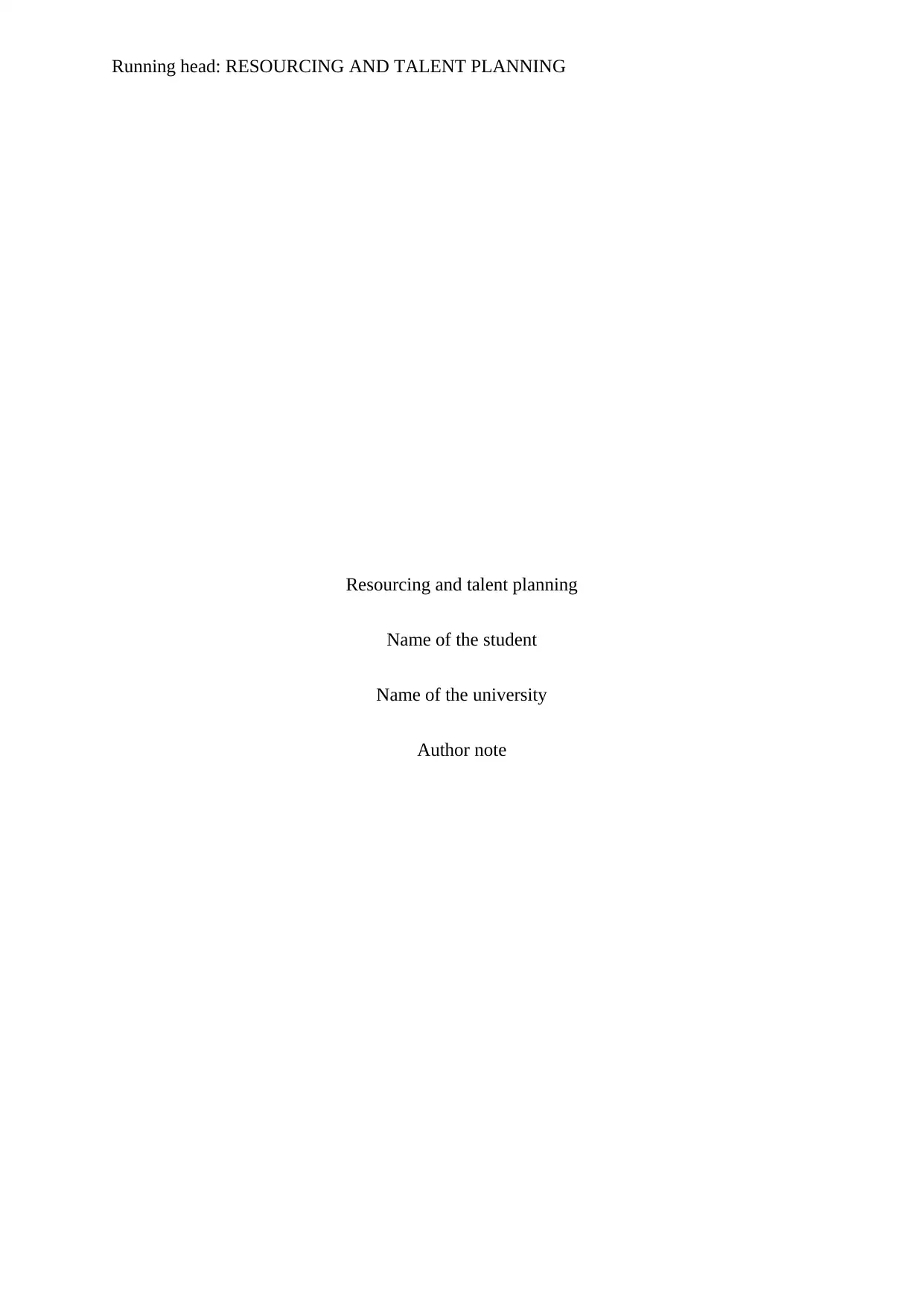
Running head: RESOURCING AND TALENT PLANNING
Resourcing and talent planning
Name of the student
Name of the university
Author note
Resourcing and talent planning
Name of the student
Name of the university
Author note
Paraphrase This Document
Need a fresh take? Get an instant paraphrase of this document with our AI Paraphraser
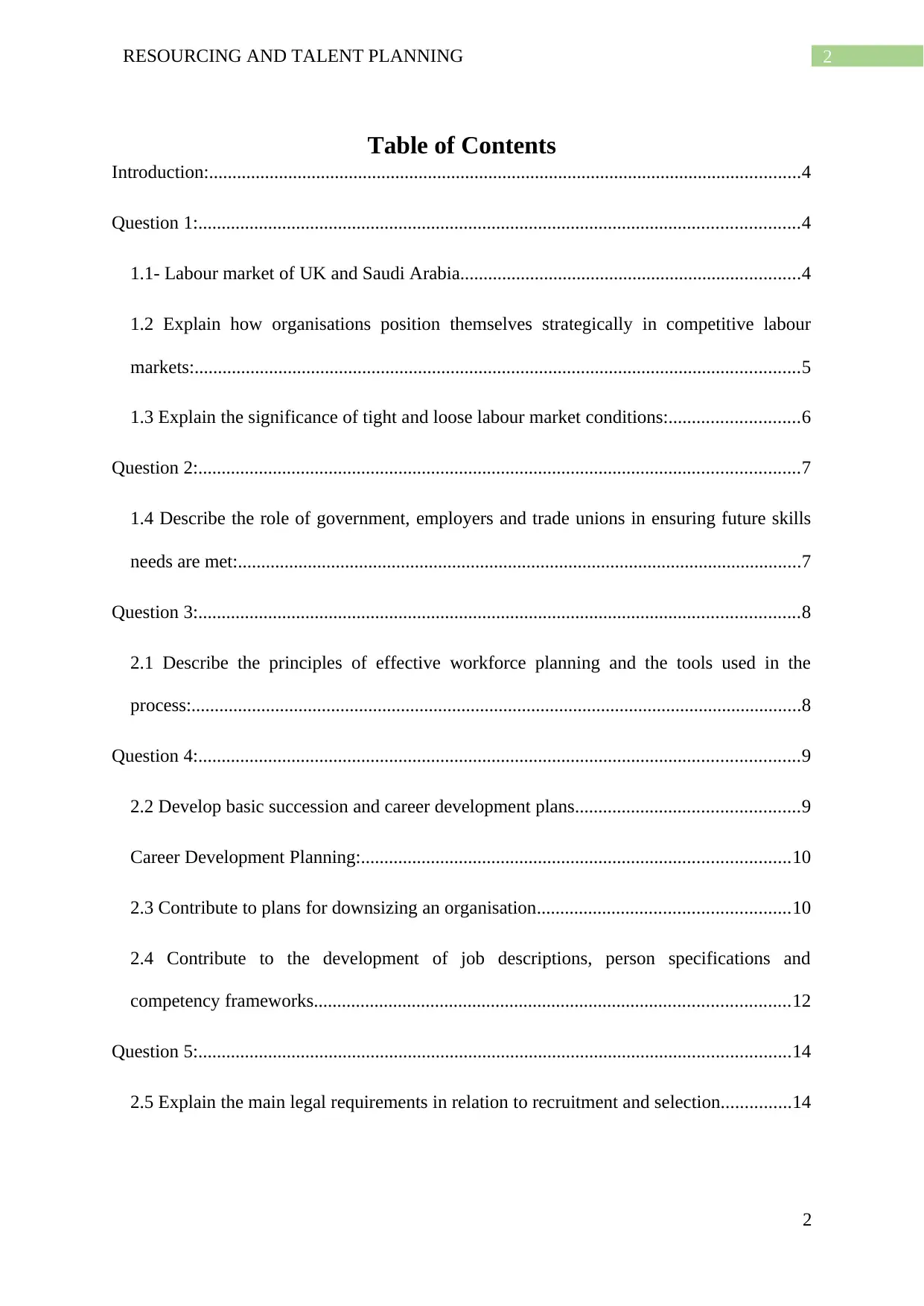
2RESOURCING AND TALENT PLANNING
Table of Contents
Introduction:...............................................................................................................................4
Question 1:.................................................................................................................................4
1.1- Labour market of UK and Saudi Arabia.........................................................................4
1.2 Explain how organisations position themselves strategically in competitive labour
markets:..................................................................................................................................5
1.3 Explain the significance of tight and loose labour market conditions:............................6
Question 2:.................................................................................................................................7
1.4 Describe the role of government, employers and trade unions in ensuring future skills
needs are met:.........................................................................................................................7
Question 3:.................................................................................................................................8
2.1 Describe the principles of effective workforce planning and the tools used in the
process:...................................................................................................................................8
Question 4:.................................................................................................................................9
2.2 Develop basic succession and career development plans................................................9
Career Development Planning:............................................................................................10
2.3 Contribute to plans for downsizing an organisation......................................................10
2.4 Contribute to the development of job descriptions, person specifications and
competency frameworks......................................................................................................12
Question 5:...............................................................................................................................14
2.5 Explain the main legal requirements in relation to recruitment and selection...............14
2
Table of Contents
Introduction:...............................................................................................................................4
Question 1:.................................................................................................................................4
1.1- Labour market of UK and Saudi Arabia.........................................................................4
1.2 Explain how organisations position themselves strategically in competitive labour
markets:..................................................................................................................................5
1.3 Explain the significance of tight and loose labour market conditions:............................6
Question 2:.................................................................................................................................7
1.4 Describe the role of government, employers and trade unions in ensuring future skills
needs are met:.........................................................................................................................7
Question 3:.................................................................................................................................8
2.1 Describe the principles of effective workforce planning and the tools used in the
process:...................................................................................................................................8
Question 4:.................................................................................................................................9
2.2 Develop basic succession and career development plans................................................9
Career Development Planning:............................................................................................10
2.3 Contribute to plans for downsizing an organisation......................................................10
2.4 Contribute to the development of job descriptions, person specifications and
competency frameworks......................................................................................................12
Question 5:...............................................................................................................................14
2.5 Explain the main legal requirements in relation to recruitment and selection...............14
2
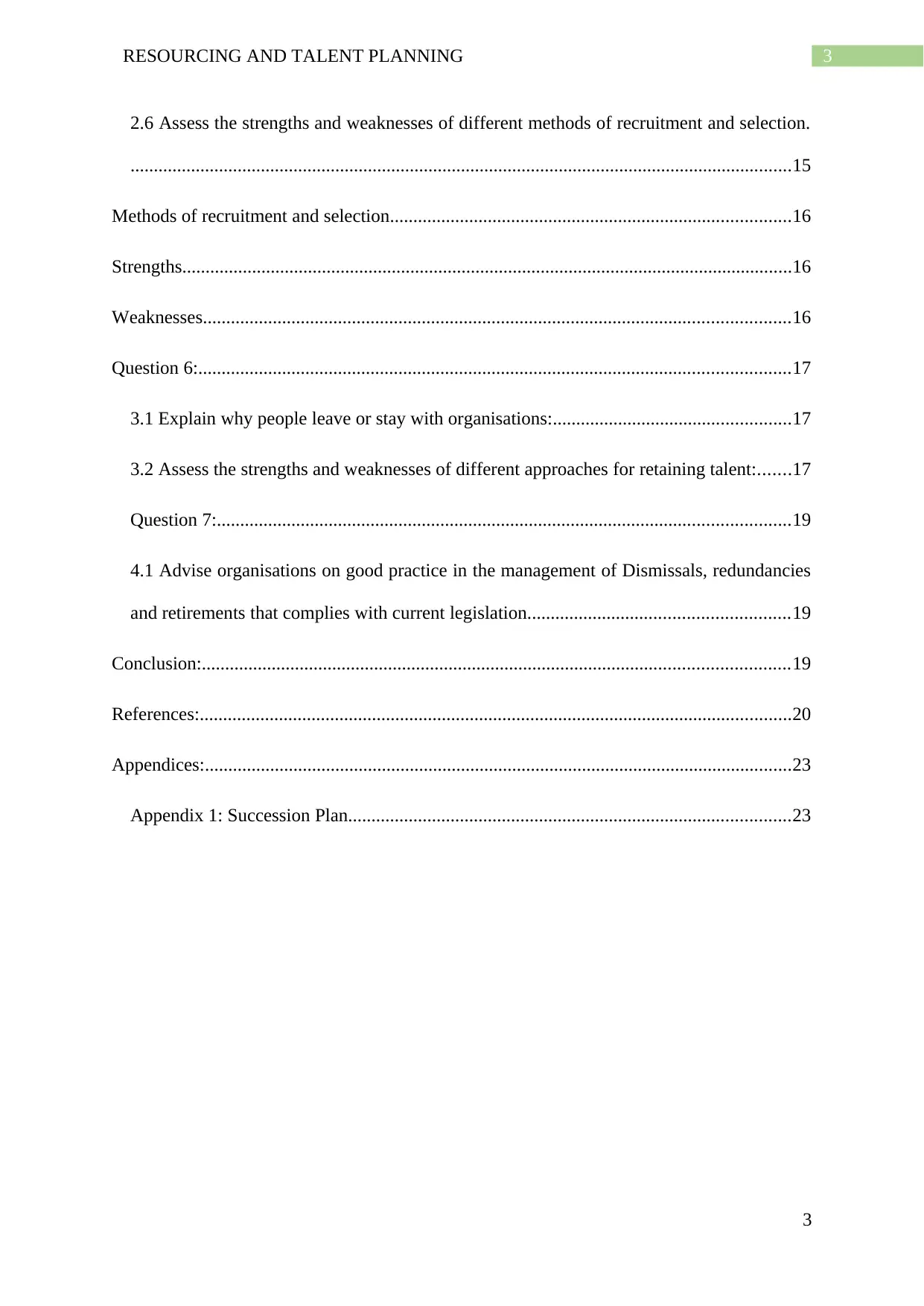
3RESOURCING AND TALENT PLANNING
2.6 Assess the strengths and weaknesses of different methods of recruitment and selection.
..............................................................................................................................................15
Methods of recruitment and selection......................................................................................16
Strengths...................................................................................................................................16
Weaknesses..............................................................................................................................16
Question 6:...............................................................................................................................17
3.1 Explain why people leave or stay with organisations:...................................................17
3.2 Assess the strengths and weaknesses of different approaches for retaining talent:.......17
Question 7:...........................................................................................................................19
4.1 Advise organisations on good practice in the management of Dismissals, redundancies
and retirements that complies with current legislation........................................................19
Conclusion:..............................................................................................................................19
References:...............................................................................................................................20
Appendices:..............................................................................................................................23
Appendix 1: Succession Plan...............................................................................................23
3
2.6 Assess the strengths and weaknesses of different methods of recruitment and selection.
..............................................................................................................................................15
Methods of recruitment and selection......................................................................................16
Strengths...................................................................................................................................16
Weaknesses..............................................................................................................................16
Question 6:...............................................................................................................................17
3.1 Explain why people leave or stay with organisations:...................................................17
3.2 Assess the strengths and weaknesses of different approaches for retaining talent:.......17
Question 7:...........................................................................................................................19
4.1 Advise organisations on good practice in the management of Dismissals, redundancies
and retirements that complies with current legislation........................................................19
Conclusion:..............................................................................................................................19
References:...............................................................................................................................20
Appendices:..............................................................................................................................23
Appendix 1: Succession Plan...............................................................................................23
3
⊘ This is a preview!⊘
Do you want full access?
Subscribe today to unlock all pages.

Trusted by 1+ million students worldwide
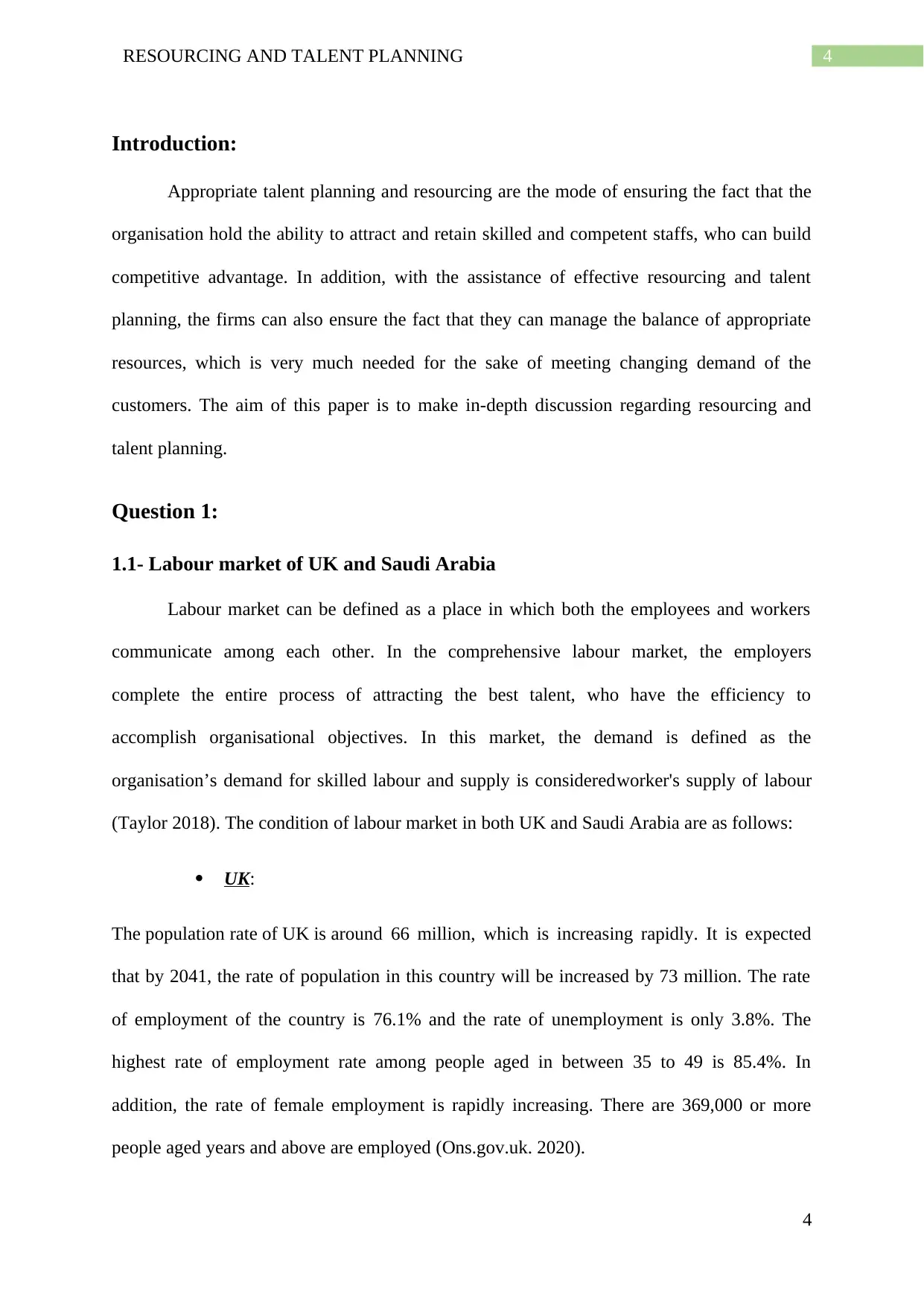
4RESOURCING AND TALENT PLANNING
Introduction:
Appropriate talent planning and resourcing are the mode of ensuring the fact that the
organisation hold the ability to attract and retain skilled and competent staffs, who can build
competitive advantage. In addition, with the assistance of effective resourcing and talent
planning, the firms can also ensure the fact that they can manage the balance of appropriate
resources, which is very much needed for the sake of meeting changing demand of the
customers. The aim of this paper is to make in-depth discussion regarding resourcing and
talent planning.
Question 1:
1.1- Labour market of UK and Saudi Arabia
Labour market can be defined as a place in which both the employees and workers
communicate among each other. In the comprehensive labour market, the employers
complete the entire process of attracting the best talent, who have the efficiency to
accomplish organisational objectives. In this market, the demand is defined as the
organisation’s demand for skilled labour and supply is consideredworker's supply of labour
(Taylor 2018). The condition of labour market in both UK and Saudi Arabia are as follows:
UK:
The population rate of UK is around 66 million, which is increasing rapidly. It is expected
that by 2041, the rate of population in this country will be increased by 73 million. The rate
of employment of the country is 76.1% and the rate of unemployment is only 3.8%. The
highest rate of employment rate among people aged in between 35 to 49 is 85.4%. In
addition, the rate of female employment is rapidly increasing. There are 369,000 or more
people aged years and above are employed (Ons.gov.uk. 2020).
4
Introduction:
Appropriate talent planning and resourcing are the mode of ensuring the fact that the
organisation hold the ability to attract and retain skilled and competent staffs, who can build
competitive advantage. In addition, with the assistance of effective resourcing and talent
planning, the firms can also ensure the fact that they can manage the balance of appropriate
resources, which is very much needed for the sake of meeting changing demand of the
customers. The aim of this paper is to make in-depth discussion regarding resourcing and
talent planning.
Question 1:
1.1- Labour market of UK and Saudi Arabia
Labour market can be defined as a place in which both the employees and workers
communicate among each other. In the comprehensive labour market, the employers
complete the entire process of attracting the best talent, who have the efficiency to
accomplish organisational objectives. In this market, the demand is defined as the
organisation’s demand for skilled labour and supply is consideredworker's supply of labour
(Taylor 2018). The condition of labour market in both UK and Saudi Arabia are as follows:
UK:
The population rate of UK is around 66 million, which is increasing rapidly. It is expected
that by 2041, the rate of population in this country will be increased by 73 million. The rate
of employment of the country is 76.1% and the rate of unemployment is only 3.8%. The
highest rate of employment rate among people aged in between 35 to 49 is 85.4%. In
addition, the rate of female employment is rapidly increasing. There are 369,000 or more
people aged years and above are employed (Ons.gov.uk. 2020).
4
Paraphrase This Document
Need a fresh take? Get an instant paraphrase of this document with our AI Paraphraser
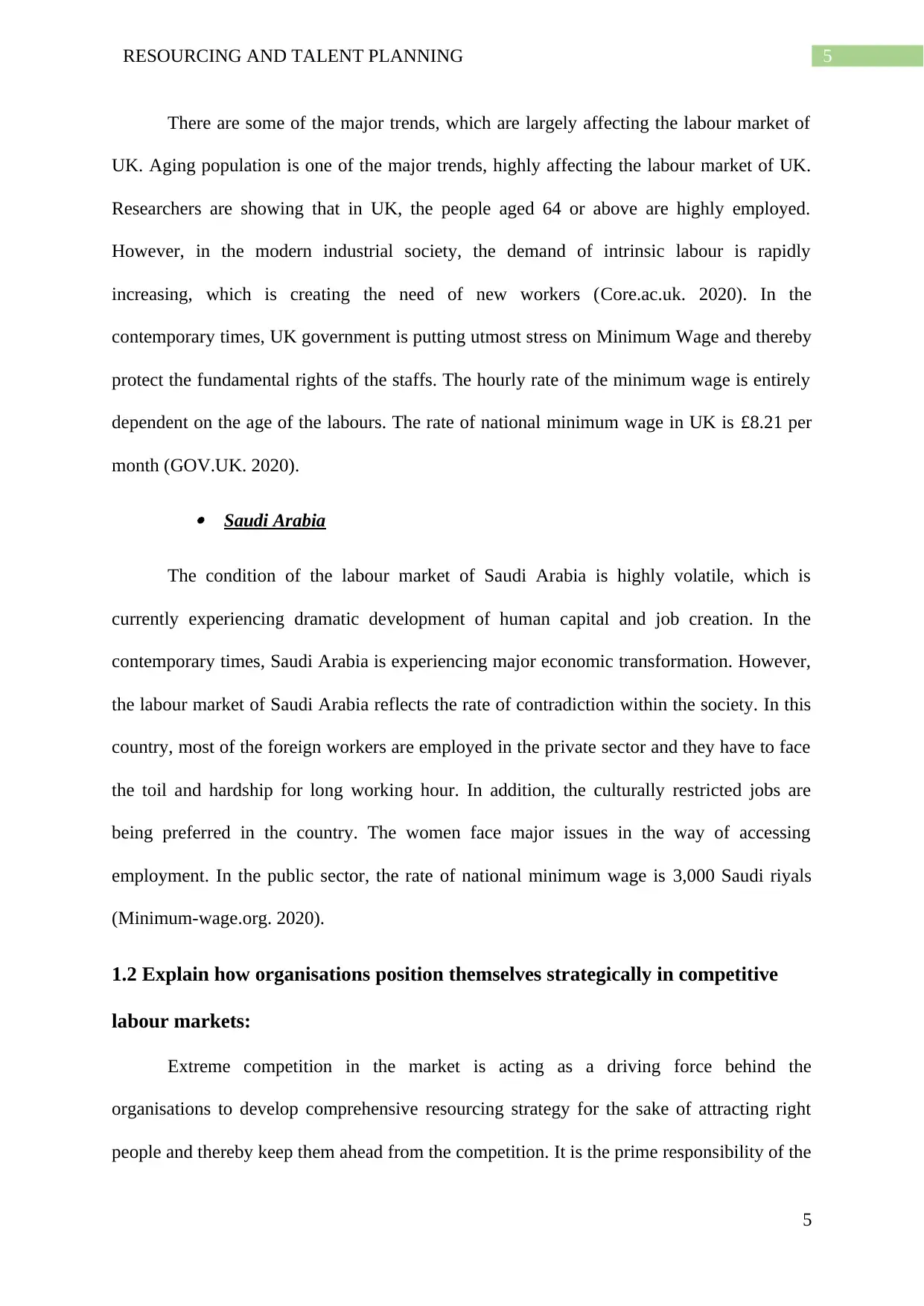
5RESOURCING AND TALENT PLANNING
There are some of the major trends, which are largely affecting the labour market of
UK. Aging population is one of the major trends, highly affecting the labour market of UK.
Researchers are showing that in UK, the people aged 64 or above are highly employed.
However, in the modern industrial society, the demand of intrinsic labour is rapidly
increasing, which is creating the need of new workers (Core.ac.uk. 2020). In the
contemporary times, UK government is putting utmost stress on Minimum Wage and thereby
protect the fundamental rights of the staffs. The hourly rate of the minimum wage is entirely
dependent on the age of the labours. The rate of national minimum wage in UK is £8.21 per
month (GOV.UK. 2020). Saudi Arabia
The condition of the labour market of Saudi Arabia is highly volatile, which is
currently experiencing dramatic development of human capital and job creation. In the
contemporary times, Saudi Arabia is experiencing major economic transformation. However,
the labour market of Saudi Arabia reflects the rate of contradiction within the society. In this
country, most of the foreign workers are employed in the private sector and they have to face
the toil and hardship for long working hour. In addition, the culturally restricted jobs are
being preferred in the country. The women face major issues in the way of accessing
employment. In the public sector, the rate of national minimum wage is 3,000 Saudi riyals
(Minimum-wage.org. 2020).
1.2 Explain how organisations position themselves strategically in competitive
labour markets:
Extreme competition in the market is acting as a driving force behind the
organisations to develop comprehensive resourcing strategy for the sake of attracting right
people and thereby keep them ahead from the competition. It is the prime responsibility of the
5
There are some of the major trends, which are largely affecting the labour market of
UK. Aging population is one of the major trends, highly affecting the labour market of UK.
Researchers are showing that in UK, the people aged 64 or above are highly employed.
However, in the modern industrial society, the demand of intrinsic labour is rapidly
increasing, which is creating the need of new workers (Core.ac.uk. 2020). In the
contemporary times, UK government is putting utmost stress on Minimum Wage and thereby
protect the fundamental rights of the staffs. The hourly rate of the minimum wage is entirely
dependent on the age of the labours. The rate of national minimum wage in UK is £8.21 per
month (GOV.UK. 2020). Saudi Arabia
The condition of the labour market of Saudi Arabia is highly volatile, which is
currently experiencing dramatic development of human capital and job creation. In the
contemporary times, Saudi Arabia is experiencing major economic transformation. However,
the labour market of Saudi Arabia reflects the rate of contradiction within the society. In this
country, most of the foreign workers are employed in the private sector and they have to face
the toil and hardship for long working hour. In addition, the culturally restricted jobs are
being preferred in the country. The women face major issues in the way of accessing
employment. In the public sector, the rate of national minimum wage is 3,000 Saudi riyals
(Minimum-wage.org. 2020).
1.2 Explain how organisations position themselves strategically in competitive
labour markets:
Extreme competition in the market is acting as a driving force behind the
organisations to develop comprehensive resourcing strategy for the sake of attracting right
people and thereby keep them ahead from the competition. It is the prime responsibility of the
5
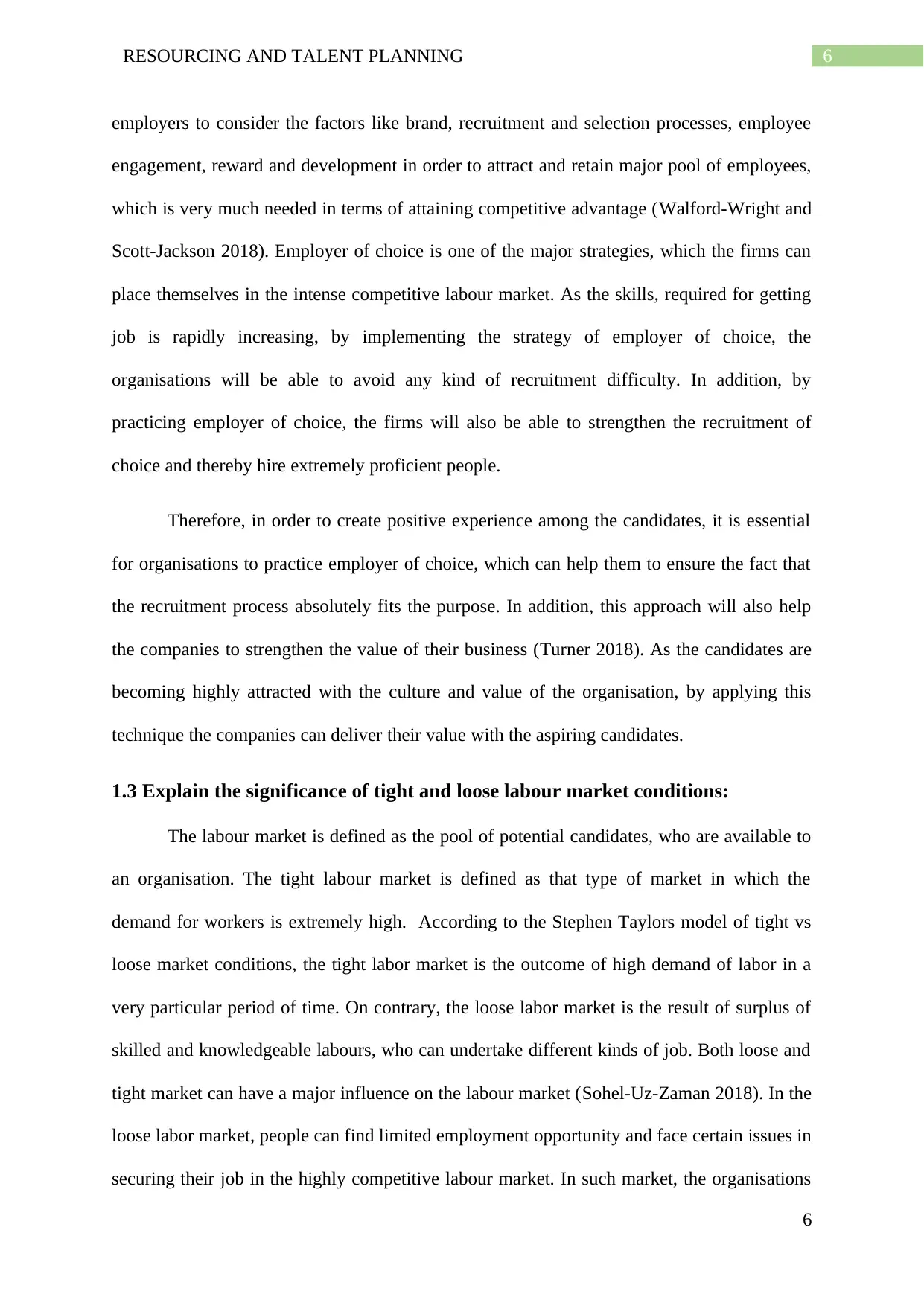
6RESOURCING AND TALENT PLANNING
employers to consider the factors like brand, recruitment and selection processes, employee
engagement, reward and development in order to attract and retain major pool of employees,
which is very much needed in terms of attaining competitive advantage (Walford-Wright and
Scott-Jackson 2018). Employer of choice is one of the major strategies, which the firms can
place themselves in the intense competitive labour market. As the skills, required for getting
job is rapidly increasing, by implementing the strategy of employer of choice, the
organisations will be able to avoid any kind of recruitment difficulty. In addition, by
practicing employer of choice, the firms will also be able to strengthen the recruitment of
choice and thereby hire extremely proficient people.
Therefore, in order to create positive experience among the candidates, it is essential
for organisations to practice employer of choice, which can help them to ensure the fact that
the recruitment process absolutely fits the purpose. In addition, this approach will also help
the companies to strengthen the value of their business (Turner 2018). As the candidates are
becoming highly attracted with the culture and value of the organisation, by applying this
technique the companies can deliver their value with the aspiring candidates.
1.3 Explain the significance of tight and loose labour market conditions:
The labour market is defined as the pool of potential candidates, who are available to
an organisation. The tight labour market is defined as that type of market in which the
demand for workers is extremely high. According to the Stephen Taylors model of tight vs
loose market conditions, the tight labor market is the outcome of high demand of labor in a
very particular period of time. On contrary, the loose labor market is the result of surplus of
skilled and knowledgeable labours, who can undertake different kinds of job. Both loose and
tight market can have a major influence on the labour market (Sohel-Uz-Zaman 2018). In the
loose labor market, people can find limited employment opportunity and face certain issues in
securing their job in the highly competitive labour market. In such market, the organisations
6
employers to consider the factors like brand, recruitment and selection processes, employee
engagement, reward and development in order to attract and retain major pool of employees,
which is very much needed in terms of attaining competitive advantage (Walford-Wright and
Scott-Jackson 2018). Employer of choice is one of the major strategies, which the firms can
place themselves in the intense competitive labour market. As the skills, required for getting
job is rapidly increasing, by implementing the strategy of employer of choice, the
organisations will be able to avoid any kind of recruitment difficulty. In addition, by
practicing employer of choice, the firms will also be able to strengthen the recruitment of
choice and thereby hire extremely proficient people.
Therefore, in order to create positive experience among the candidates, it is essential
for organisations to practice employer of choice, which can help them to ensure the fact that
the recruitment process absolutely fits the purpose. In addition, this approach will also help
the companies to strengthen the value of their business (Turner 2018). As the candidates are
becoming highly attracted with the culture and value of the organisation, by applying this
technique the companies can deliver their value with the aspiring candidates.
1.3 Explain the significance of tight and loose labour market conditions:
The labour market is defined as the pool of potential candidates, who are available to
an organisation. The tight labour market is defined as that type of market in which the
demand for workers is extremely high. According to the Stephen Taylors model of tight vs
loose market conditions, the tight labor market is the outcome of high demand of labor in a
very particular period of time. On contrary, the loose labor market is the result of surplus of
skilled and knowledgeable labours, who can undertake different kinds of job. Both loose and
tight market can have a major influence on the labour market (Sohel-Uz-Zaman 2018). In the
loose labor market, people can find limited employment opportunity and face certain issues in
securing their job in the highly competitive labour market. In such market, the organisations
6
⊘ This is a preview!⊘
Do you want full access?
Subscribe today to unlock all pages.

Trusted by 1+ million students worldwide
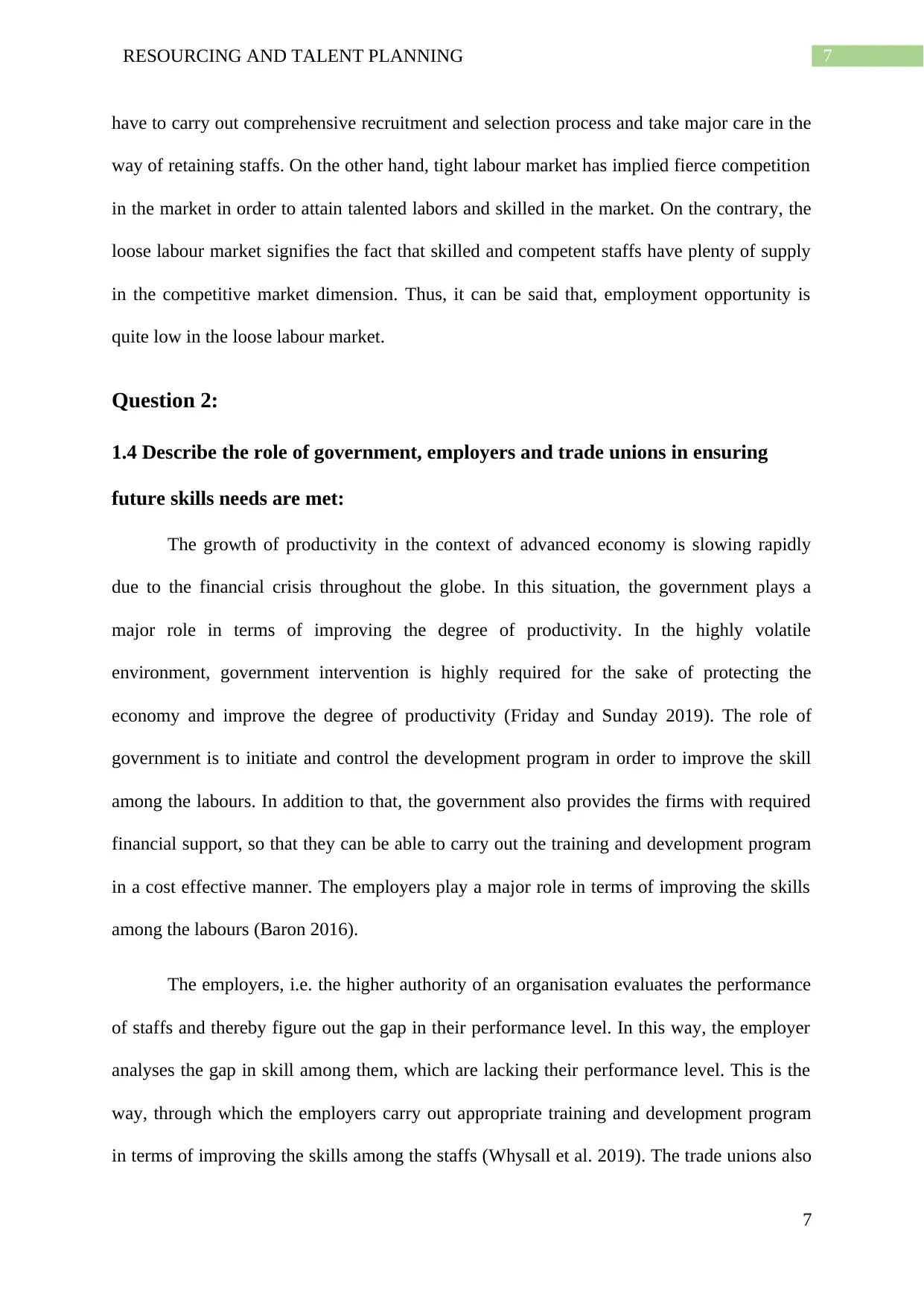
7RESOURCING AND TALENT PLANNING
have to carry out comprehensive recruitment and selection process and take major care in the
way of retaining staffs. On the other hand, tight labour market has implied fierce competition
in the market in order to attain talented labors and skilled in the market. On the contrary, the
loose labour market signifies the fact that skilled and competent staffs have plenty of supply
in the competitive market dimension. Thus, it can be said that, employment opportunity is
quite low in the loose labour market.
Question 2:
1.4 Describe the role of government, employers and trade unions in ensuring
future skills needs are met:
The growth of productivity in the context of advanced economy is slowing rapidly
due to the financial crisis throughout the globe. In this situation, the government plays a
major role in terms of improving the degree of productivity. In the highly volatile
environment, government intervention is highly required for the sake of protecting the
economy and improve the degree of productivity (Friday and Sunday 2019). The role of
government is to initiate and control the development program in order to improve the skill
among the labours. In addition to that, the government also provides the firms with required
financial support, so that they can be able to carry out the training and development program
in a cost effective manner. The employers play a major role in terms of improving the skills
among the labours (Baron 2016).
The employers, i.e. the higher authority of an organisation evaluates the performance
of staffs and thereby figure out the gap in their performance level. In this way, the employer
analyses the gap in skill among them, which are lacking their performance level. This is the
way, through which the employers carry out appropriate training and development program
in terms of improving the skills among the staffs (Whysall et al. 2019). The trade unions also
7
have to carry out comprehensive recruitment and selection process and take major care in the
way of retaining staffs. On the other hand, tight labour market has implied fierce competition
in the market in order to attain talented labors and skilled in the market. On the contrary, the
loose labour market signifies the fact that skilled and competent staffs have plenty of supply
in the competitive market dimension. Thus, it can be said that, employment opportunity is
quite low in the loose labour market.
Question 2:
1.4 Describe the role of government, employers and trade unions in ensuring
future skills needs are met:
The growth of productivity in the context of advanced economy is slowing rapidly
due to the financial crisis throughout the globe. In this situation, the government plays a
major role in terms of improving the degree of productivity. In the highly volatile
environment, government intervention is highly required for the sake of protecting the
economy and improve the degree of productivity (Friday and Sunday 2019). The role of
government is to initiate and control the development program in order to improve the skill
among the labours. In addition to that, the government also provides the firms with required
financial support, so that they can be able to carry out the training and development program
in a cost effective manner. The employers play a major role in terms of improving the skills
among the labours (Baron 2016).
The employers, i.e. the higher authority of an organisation evaluates the performance
of staffs and thereby figure out the gap in their performance level. In this way, the employer
analyses the gap in skill among them, which are lacking their performance level. This is the
way, through which the employers carry out appropriate training and development program
in terms of improving the skills among the staffs (Whysall et al. 2019). The trade unions also
7
Paraphrase This Document
Need a fresh take? Get an instant paraphrase of this document with our AI Paraphraser
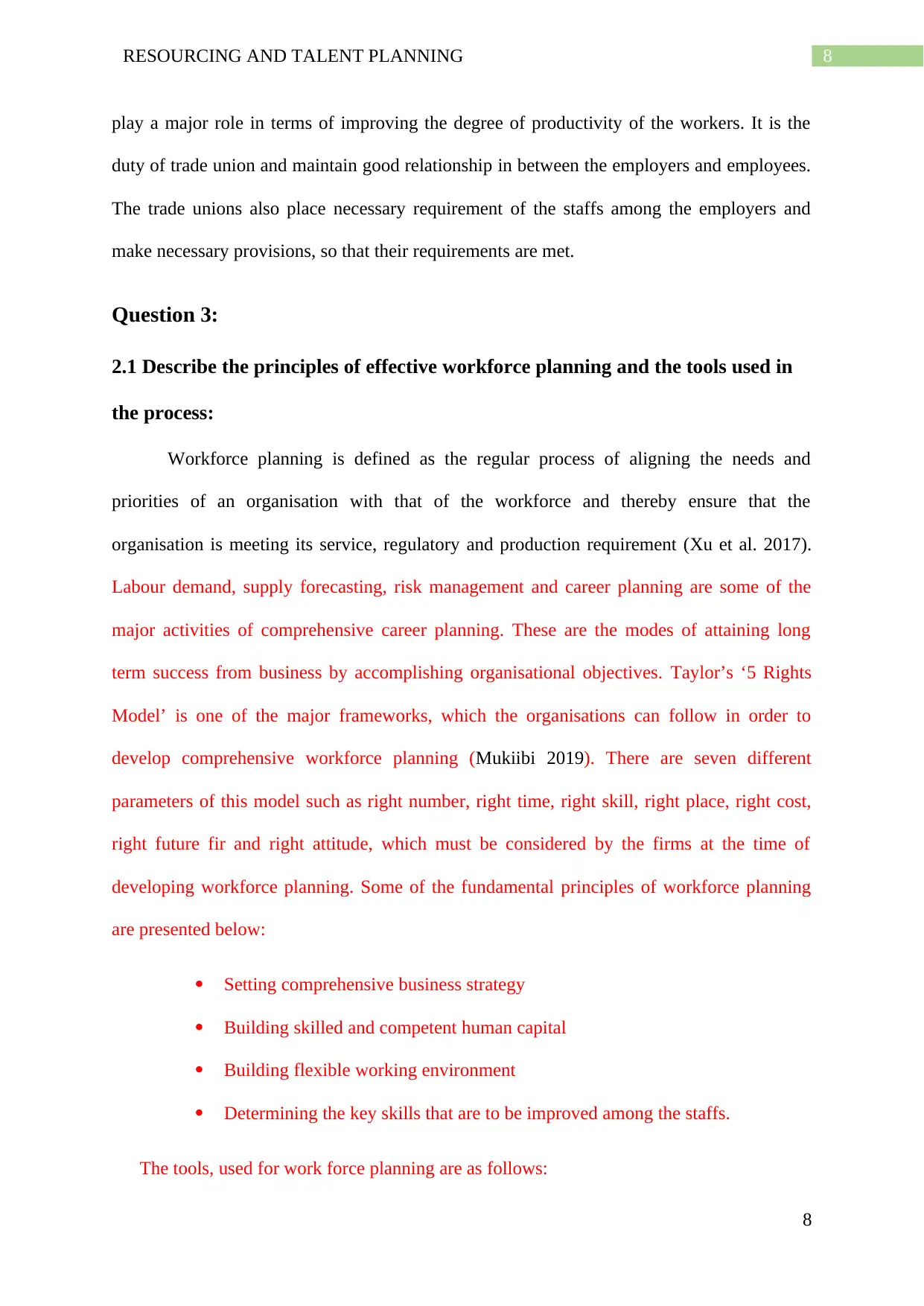
8RESOURCING AND TALENT PLANNING
play a major role in terms of improving the degree of productivity of the workers. It is the
duty of trade union and maintain good relationship in between the employers and employees.
The trade unions also place necessary requirement of the staffs among the employers and
make necessary provisions, so that their requirements are met.
Question 3:
2.1 Describe the principles of effective workforce planning and the tools used in
the process:
Workforce planning is defined as the regular process of aligning the needs and
priorities of an organisation with that of the workforce and thereby ensure that the
organisation is meeting its service, regulatory and production requirement (Xu et al. 2017).
Labour demand, supply forecasting, risk management and career planning are some of the
major activities of comprehensive career planning. These are the modes of attaining long
term success from business by accomplishing organisational objectives. Taylor’s ‘5 Rights
Model’ is one of the major frameworks, which the organisations can follow in order to
develop comprehensive workforce planning (Mukiibi 2019). There are seven different
parameters of this model such as right number, right time, right skill, right place, right cost,
right future fir and right attitude, which must be considered by the firms at the time of
developing workforce planning. Some of the fundamental principles of workforce planning
are presented below:
Setting comprehensive business strategy
Building skilled and competent human capital
Building flexible working environment
Determining the key skills that are to be improved among the staffs.
The tools, used for work force planning are as follows:
8
play a major role in terms of improving the degree of productivity of the workers. It is the
duty of trade union and maintain good relationship in between the employers and employees.
The trade unions also place necessary requirement of the staffs among the employers and
make necessary provisions, so that their requirements are met.
Question 3:
2.1 Describe the principles of effective workforce planning and the tools used in
the process:
Workforce planning is defined as the regular process of aligning the needs and
priorities of an organisation with that of the workforce and thereby ensure that the
organisation is meeting its service, regulatory and production requirement (Xu et al. 2017).
Labour demand, supply forecasting, risk management and career planning are some of the
major activities of comprehensive career planning. These are the modes of attaining long
term success from business by accomplishing organisational objectives. Taylor’s ‘5 Rights
Model’ is one of the major frameworks, which the organisations can follow in order to
develop comprehensive workforce planning (Mukiibi 2019). There are seven different
parameters of this model such as right number, right time, right skill, right place, right cost,
right future fir and right attitude, which must be considered by the firms at the time of
developing workforce planning. Some of the fundamental principles of workforce planning
are presented below:
Setting comprehensive business strategy
Building skilled and competent human capital
Building flexible working environment
Determining the key skills that are to be improved among the staffs.
The tools, used for work force planning are as follows:
8
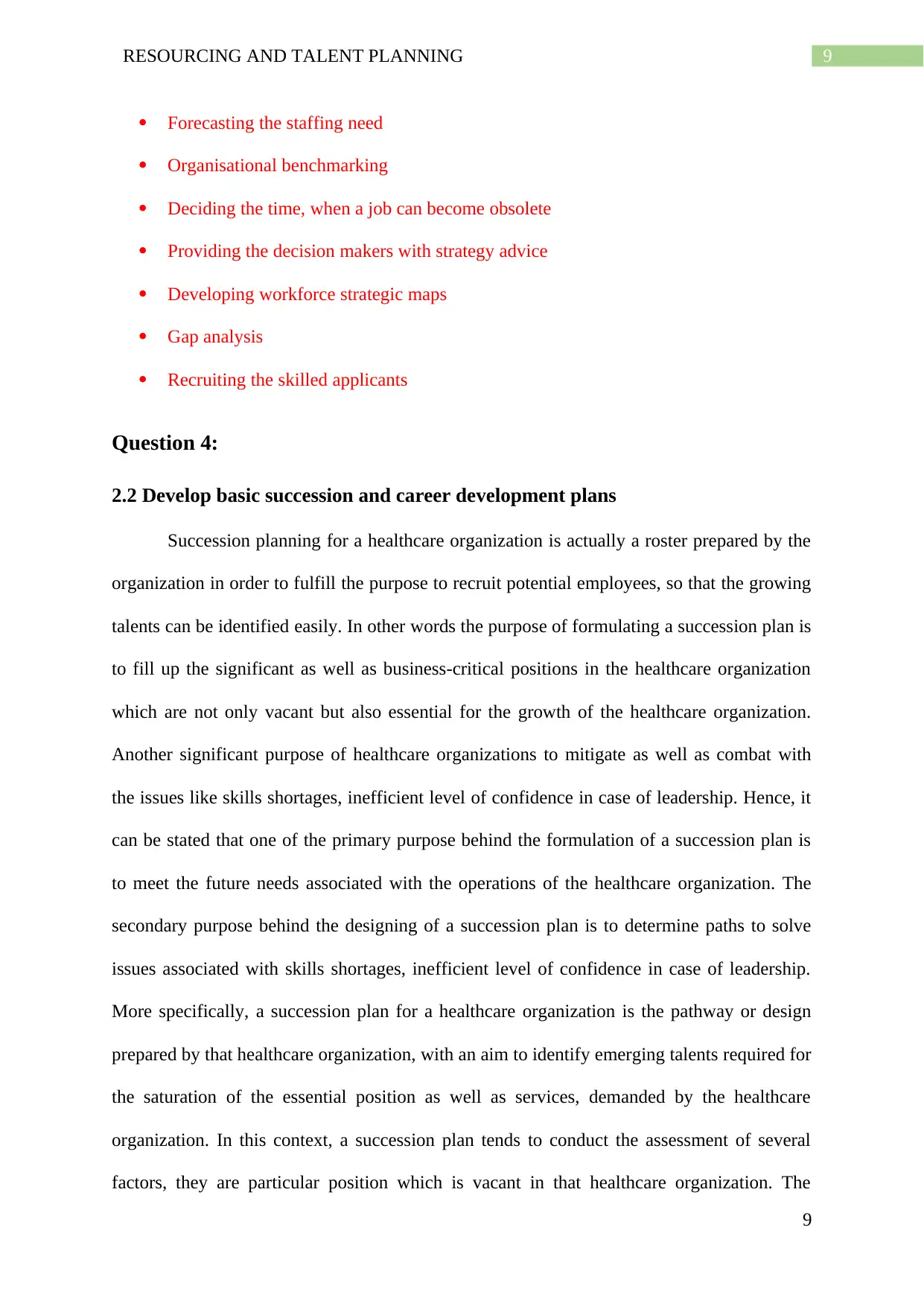
9RESOURCING AND TALENT PLANNING
Forecasting the staffing need
Organisational benchmarking
Deciding the time, when a job can become obsolete
Providing the decision makers with strategy advice
Developing workforce strategic maps
Gap analysis
Recruiting the skilled applicants
Question 4:
2.2 Develop basic succession and career development plans
Succession planning for a healthcare organization is actually a roster prepared by the
organization in order to fulfill the purpose to recruit potential employees, so that the growing
talents can be identified easily. In other words the purpose of formulating a succession plan is
to fill up the significant as well as business-critical positions in the healthcare organization
which are not only vacant but also essential for the growth of the healthcare organization.
Another significant purpose of healthcare organizations to mitigate as well as combat with
the issues like skills shortages, inefficient level of confidence in case of leadership. Hence, it
can be stated that one of the primary purpose behind the formulation of a succession plan is
to meet the future needs associated with the operations of the healthcare organization. The
secondary purpose behind the designing of a succession plan is to determine paths to solve
issues associated with skills shortages, inefficient level of confidence in case of leadership.
More specifically, a succession plan for a healthcare organization is the pathway or design
prepared by that healthcare organization, with an aim to identify emerging talents required for
the saturation of the essential position as well as services, demanded by the healthcare
organization. In this context, a succession plan tends to conduct the assessment of several
factors, they are particular position which is vacant in that healthcare organization. The
9
Forecasting the staffing need
Organisational benchmarking
Deciding the time, when a job can become obsolete
Providing the decision makers with strategy advice
Developing workforce strategic maps
Gap analysis
Recruiting the skilled applicants
Question 4:
2.2 Develop basic succession and career development plans
Succession planning for a healthcare organization is actually a roster prepared by the
organization in order to fulfill the purpose to recruit potential employees, so that the growing
talents can be identified easily. In other words the purpose of formulating a succession plan is
to fill up the significant as well as business-critical positions in the healthcare organization
which are not only vacant but also essential for the growth of the healthcare organization.
Another significant purpose of healthcare organizations to mitigate as well as combat with
the issues like skills shortages, inefficient level of confidence in case of leadership. Hence, it
can be stated that one of the primary purpose behind the formulation of a succession plan is
to meet the future needs associated with the operations of the healthcare organization. The
secondary purpose behind the designing of a succession plan is to determine paths to solve
issues associated with skills shortages, inefficient level of confidence in case of leadership.
More specifically, a succession plan for a healthcare organization is the pathway or design
prepared by that healthcare organization, with an aim to identify emerging talents required for
the saturation of the essential position as well as services, demanded by the healthcare
organization. In this context, a succession plan tends to conduct the assessment of several
factors, they are particular position which is vacant in that healthcare organization. The
9
⊘ This is a preview!⊘
Do you want full access?
Subscribe today to unlock all pages.

Trusted by 1+ million students worldwide
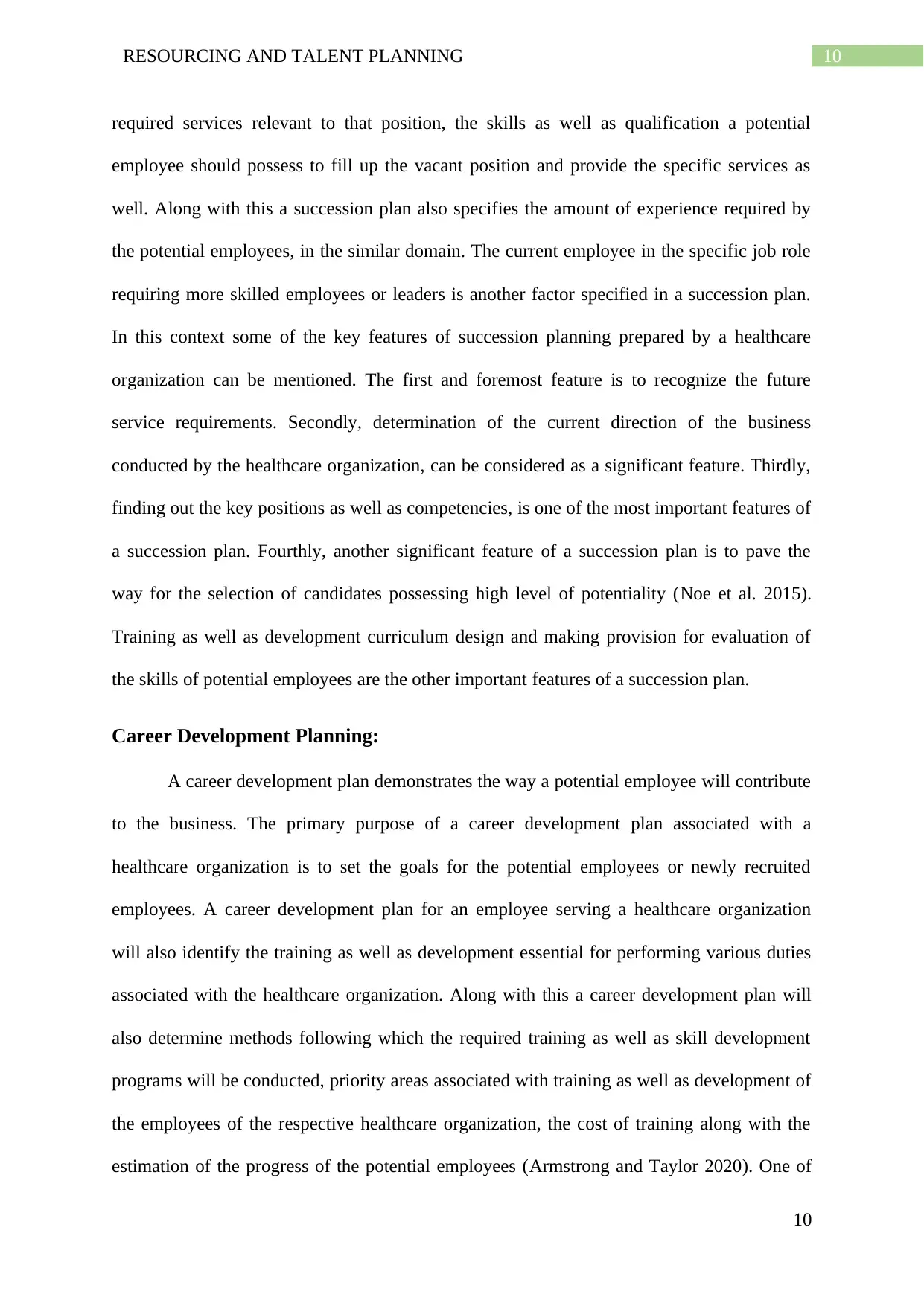
10RESOURCING AND TALENT PLANNING
required services relevant to that position, the skills as well as qualification a potential
employee should possess to fill up the vacant position and provide the specific services as
well. Along with this a succession plan also specifies the amount of experience required by
the potential employees, in the similar domain. The current employee in the specific job role
requiring more skilled employees or leaders is another factor specified in a succession plan.
In this context some of the key features of succession planning prepared by a healthcare
organization can be mentioned. The first and foremost feature is to recognize the future
service requirements. Secondly, determination of the current direction of the business
conducted by the healthcare organization, can be considered as a significant feature. Thirdly,
finding out the key positions as well as competencies, is one of the most important features of
a succession plan. Fourthly, another significant feature of a succession plan is to pave the
way for the selection of candidates possessing high level of potentiality (Noe et al. 2015).
Training as well as development curriculum design and making provision for evaluation of
the skills of potential employees are the other important features of a succession plan.
Career Development Planning:
A career development plan demonstrates the way a potential employee will contribute
to the business. The primary purpose of a career development plan associated with a
healthcare organization is to set the goals for the potential employees or newly recruited
employees. A career development plan for an employee serving a healthcare organization
will also identify the training as well as development essential for performing various duties
associated with the healthcare organization. Along with this a career development plan will
also determine methods following which the required training as well as skill development
programs will be conducted, priority areas associated with training as well as development of
the employees of the respective healthcare organization, the cost of training along with the
estimation of the progress of the potential employees (Armstrong and Taylor 2020). One of
10
required services relevant to that position, the skills as well as qualification a potential
employee should possess to fill up the vacant position and provide the specific services as
well. Along with this a succession plan also specifies the amount of experience required by
the potential employees, in the similar domain. The current employee in the specific job role
requiring more skilled employees or leaders is another factor specified in a succession plan.
In this context some of the key features of succession planning prepared by a healthcare
organization can be mentioned. The first and foremost feature is to recognize the future
service requirements. Secondly, determination of the current direction of the business
conducted by the healthcare organization, can be considered as a significant feature. Thirdly,
finding out the key positions as well as competencies, is one of the most important features of
a succession plan. Fourthly, another significant feature of a succession plan is to pave the
way for the selection of candidates possessing high level of potentiality (Noe et al. 2015).
Training as well as development curriculum design and making provision for evaluation of
the skills of potential employees are the other important features of a succession plan.
Career Development Planning:
A career development plan demonstrates the way a potential employee will contribute
to the business. The primary purpose of a career development plan associated with a
healthcare organization is to set the goals for the potential employees or newly recruited
employees. A career development plan for an employee serving a healthcare organization
will also identify the training as well as development essential for performing various duties
associated with the healthcare organization. Along with this a career development plan will
also determine methods following which the required training as well as skill development
programs will be conducted, priority areas associated with training as well as development of
the employees of the respective healthcare organization, the cost of training along with the
estimation of the progress of the potential employees (Armstrong and Taylor 2020). One of
10
Paraphrase This Document
Need a fresh take? Get an instant paraphrase of this document with our AI Paraphraser
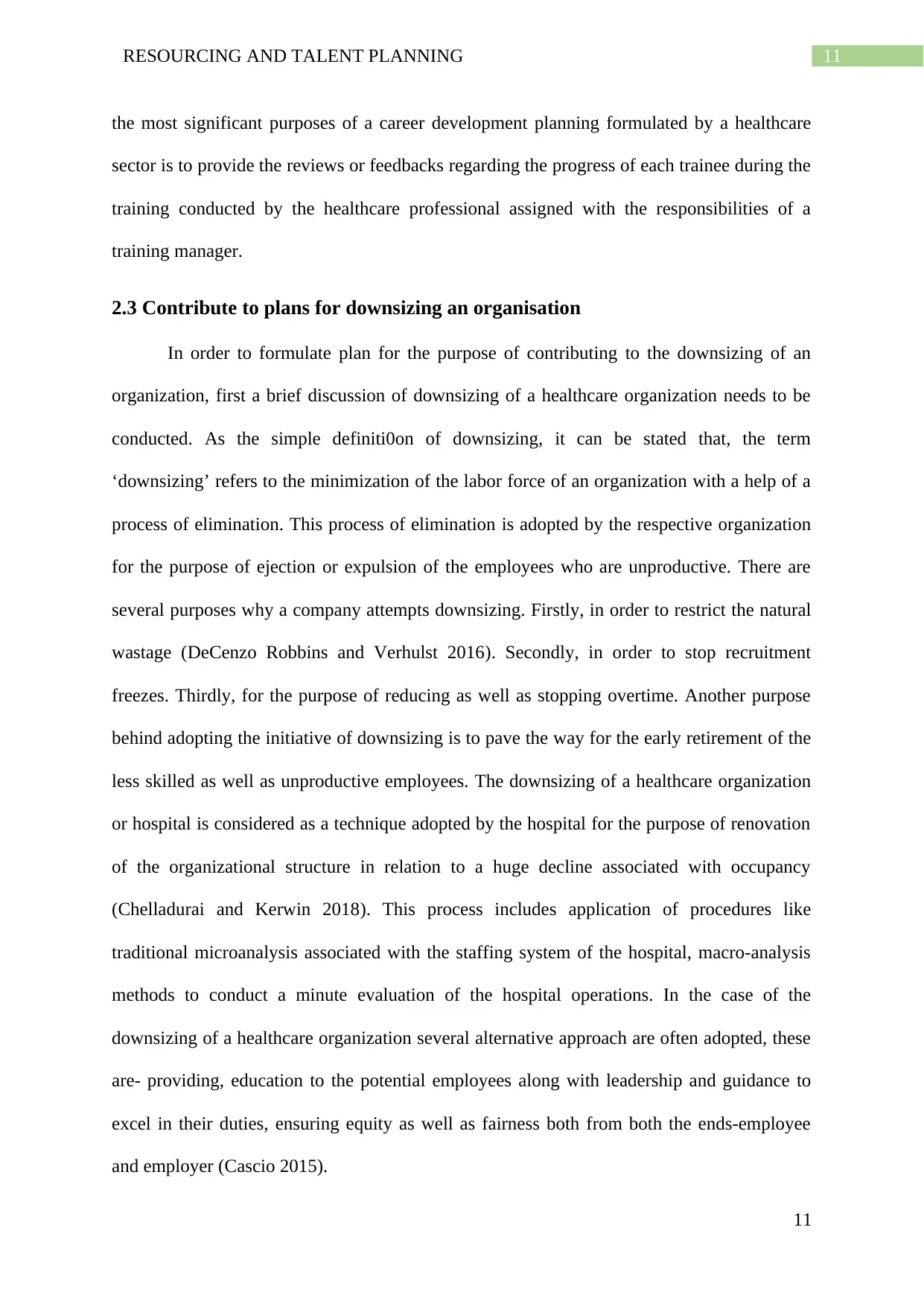
11RESOURCING AND TALENT PLANNING
the most significant purposes of a career development planning formulated by a healthcare
sector is to provide the reviews or feedbacks regarding the progress of each trainee during the
training conducted by the healthcare professional assigned with the responsibilities of a
training manager.
2.3 Contribute to plans for downsizing an organisation
In order to formulate plan for the purpose of contributing to the downsizing of an
organization, first a brief discussion of downsizing of a healthcare organization needs to be
conducted. As the simple definiti0on of downsizing, it can be stated that, the term
‘downsizing’ refers to the minimization of the labor force of an organization with a help of a
process of elimination. This process of elimination is adopted by the respective organization
for the purpose of ejection or expulsion of the employees who are unproductive. There are
several purposes why a company attempts downsizing. Firstly, in order to restrict the natural
wastage (DeCenzo Robbins and Verhulst 2016). Secondly, in order to stop recruitment
freezes. Thirdly, for the purpose of reducing as well as stopping overtime. Another purpose
behind adopting the initiative of downsizing is to pave the way for the early retirement of the
less skilled as well as unproductive employees. The downsizing of a healthcare organization
or hospital is considered as a technique adopted by the hospital for the purpose of renovation
of the organizational structure in relation to a huge decline associated with occupancy
(Chelladurai and Kerwin 2018). This process includes application of procedures like
traditional microanalysis associated with the staffing system of the hospital, macro-analysis
methods to conduct a minute evaluation of the hospital operations. In the case of the
downsizing of a healthcare organization several alternative approach are often adopted, these
are- providing, education to the potential employees along with leadership and guidance to
excel in their duties, ensuring equity as well as fairness both from both the ends-employee
and employer (Cascio 2015).
11
the most significant purposes of a career development planning formulated by a healthcare
sector is to provide the reviews or feedbacks regarding the progress of each trainee during the
training conducted by the healthcare professional assigned with the responsibilities of a
training manager.
2.3 Contribute to plans for downsizing an organisation
In order to formulate plan for the purpose of contributing to the downsizing of an
organization, first a brief discussion of downsizing of a healthcare organization needs to be
conducted. As the simple definiti0on of downsizing, it can be stated that, the term
‘downsizing’ refers to the minimization of the labor force of an organization with a help of a
process of elimination. This process of elimination is adopted by the respective organization
for the purpose of ejection or expulsion of the employees who are unproductive. There are
several purposes why a company attempts downsizing. Firstly, in order to restrict the natural
wastage (DeCenzo Robbins and Verhulst 2016). Secondly, in order to stop recruitment
freezes. Thirdly, for the purpose of reducing as well as stopping overtime. Another purpose
behind adopting the initiative of downsizing is to pave the way for the early retirement of the
less skilled as well as unproductive employees. The downsizing of a healthcare organization
or hospital is considered as a technique adopted by the hospital for the purpose of renovation
of the organizational structure in relation to a huge decline associated with occupancy
(Chelladurai and Kerwin 2018). This process includes application of procedures like
traditional microanalysis associated with the staffing system of the hospital, macro-analysis
methods to conduct a minute evaluation of the hospital operations. In the case of the
downsizing of a healthcare organization several alternative approach are often adopted, these
are- providing, education to the potential employees along with leadership and guidance to
excel in their duties, ensuring equity as well as fairness both from both the ends-employee
and employer (Cascio 2015).
11
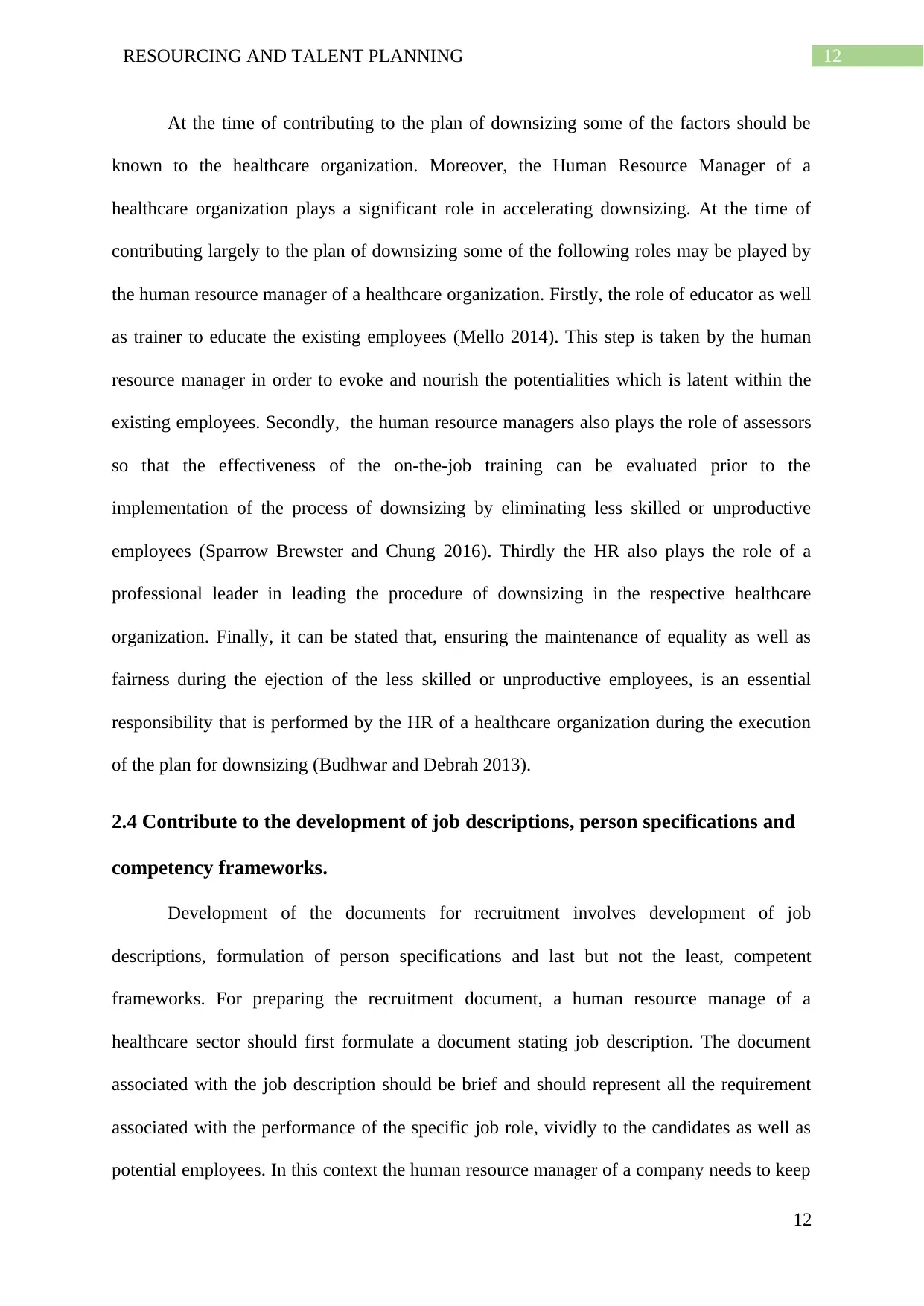
12RESOURCING AND TALENT PLANNING
At the time of contributing to the plan of downsizing some of the factors should be
known to the healthcare organization. Moreover, the Human Resource Manager of a
healthcare organization plays a significant role in accelerating downsizing. At the time of
contributing largely to the plan of downsizing some of the following roles may be played by
the human resource manager of a healthcare organization. Firstly, the role of educator as well
as trainer to educate the existing employees (Mello 2014). This step is taken by the human
resource manager in order to evoke and nourish the potentialities which is latent within the
existing employees. Secondly, the human resource managers also plays the role of assessors
so that the effectiveness of the on-the-job training can be evaluated prior to the
implementation of the process of downsizing by eliminating less skilled or unproductive
employees (Sparrow Brewster and Chung 2016). Thirdly the HR also plays the role of a
professional leader in leading the procedure of downsizing in the respective healthcare
organization. Finally, it can be stated that, ensuring the maintenance of equality as well as
fairness during the ejection of the less skilled or unproductive employees, is an essential
responsibility that is performed by the HR of a healthcare organization during the execution
of the plan for downsizing (Budhwar and Debrah 2013).
2.4 Contribute to the development of job descriptions, person specifications and
competency frameworks.
Development of the documents for recruitment involves development of job
descriptions, formulation of person specifications and last but not the least, competent
frameworks. For preparing the recruitment document, a human resource manage of a
healthcare sector should first formulate a document stating job description. The document
associated with the job description should be brief and should represent all the requirement
associated with the performance of the specific job role, vividly to the candidates as well as
potential employees. In this context the human resource manager of a company needs to keep
12
At the time of contributing to the plan of downsizing some of the factors should be
known to the healthcare organization. Moreover, the Human Resource Manager of a
healthcare organization plays a significant role in accelerating downsizing. At the time of
contributing largely to the plan of downsizing some of the following roles may be played by
the human resource manager of a healthcare organization. Firstly, the role of educator as well
as trainer to educate the existing employees (Mello 2014). This step is taken by the human
resource manager in order to evoke and nourish the potentialities which is latent within the
existing employees. Secondly, the human resource managers also plays the role of assessors
so that the effectiveness of the on-the-job training can be evaluated prior to the
implementation of the process of downsizing by eliminating less skilled or unproductive
employees (Sparrow Brewster and Chung 2016). Thirdly the HR also plays the role of a
professional leader in leading the procedure of downsizing in the respective healthcare
organization. Finally, it can be stated that, ensuring the maintenance of equality as well as
fairness during the ejection of the less skilled or unproductive employees, is an essential
responsibility that is performed by the HR of a healthcare organization during the execution
of the plan for downsizing (Budhwar and Debrah 2013).
2.4 Contribute to the development of job descriptions, person specifications and
competency frameworks.
Development of the documents for recruitment involves development of job
descriptions, formulation of person specifications and last but not the least, competent
frameworks. For preparing the recruitment document, a human resource manage of a
healthcare sector should first formulate a document stating job description. The document
associated with the job description should be brief and should represent all the requirement
associated with the performance of the specific job role, vividly to the candidates as well as
potential employees. In this context the human resource manager of a company needs to keep
12
⊘ This is a preview!⊘
Do you want full access?
Subscribe today to unlock all pages.

Trusted by 1+ million students worldwide
1 out of 26
Related Documents
Your All-in-One AI-Powered Toolkit for Academic Success.
+13062052269
info@desklib.com
Available 24*7 on WhatsApp / Email
![[object Object]](/_next/static/media/star-bottom.7253800d.svg)
Unlock your academic potential
Copyright © 2020–2025 A2Z Services. All Rights Reserved. Developed and managed by ZUCOL.





